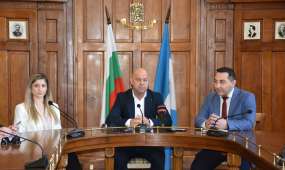Antiquity
Rudiments of state
During VI century and the first half of V century BC, the center of the Bessi’s political power were the western parts of the Plovdiv field, while the eastern parts are inhabited by the large Thracian tribe of Odrisses. After the establishment of the Odrysian state in the middle of V century BC, it began to play a dominant role in these lands and absorbed the state union of the Bessi.
In the middle of IV century BC ancient Macedonia stood as a major military-political factor in the Southeastern Europe. In 342 BC, Macedonian ruler Philip II broke the resistance of the Thracians and subjugated them. He evaluated the important geographical and strategic position of the Thracian settlement of Nebet Tepe and turned it into a support post of the subsequent expansion. Ancient authors noted that the city was Philip’s work, and therefore it bears his name – Philippopolis. Thracians adopted that name and translated it as Pulpudeva. Despite of the brief Macedonian colonization in Thrace, mid IV century BC is considered as the beginning of its urbanization. After the IV century BC Philippopolis grew as political and economic center of Thrace. New walls were constructed, which encircle the Three hills.
The distribution of coins with the inscription “Odrisses” in the city and its region and data from archaeological studies have shown that during this period the city and its surroundings were inhabited by Odrisses. Some researchers believe that the Thracian name of the town at the end of III – II century BC was Odrisses and it was the chief political and administrative center of the Odrysian state. The ancient Greek historian Polybius in his “History” describes the conquest of Philippopolis by the Macedonian ruler Philip V in 189 BC. Here is part of his story:
“...He set out with his army against the barbarians. He crossed the mid of Thrace and invaded the lands of the Odrysae, the Bessae and the Denteleti. When they reached the so-called Philippopolis, its inhabitants fled to the neighboring mountains and he took the city by assault. After he tramped the whole plain and exterminated some of the residents and other assured him in their loyalty, he withdrew leaving a garrison in Philippopolis. The garrison, however, was expelled by the Odrisses, who immediately renounced from the given promises ...”
This period of comprehensive bloom of the Thracian society is richly documented with archaeological material. The Thracians were excellent warriors, builders, farmers, shepherds, miners and craftsmen. The most significant finding is the extraordinary Panagyurishte Treasure that is stored in the Archaeological Museum in Plovdiv. It is made of pure gold with total weight of 6.154 kilograms probably in the Anatolian city Lampsakos and is not only a masterpiece of the Thracian toreutics but an important testament to the political relations of the dynastic houses and Asia Minor.
Roman province
In the I century BC a Roman expansion began in the land of the Thracians. Philippopolis and its area became the scene of violent bloody battles. In 72 BC the Roman general Marcus Terentius Varro Lucullus conquered the valley of Maritsa for the first time, including Philippopolis, which the Romans called Trimontsium (The city of three hills).
The Romans made the Thracian kings their vassals. In 15-11 BC the great rebellion of the Bessi broke out, led by their priest Vologes. The resistance of one of the powerful Thracian tribes was smashed and part of it was enslaved and sold away from Thrace, and another part was later resettled in today’s Dobrudja. By 45 AD there was a Thracian kingdom, a Roman vassal, which included the lands of present-day Plovdiv region. In 21 AD erupted a great uprising of Odrysians, Diies and Coilaletaes. They even besieged Philippopolis where the residence of the Roman viceroyalty was.
In 26 BC the Thracians living north of Philippopolis to the Balkan mountain started an another uprising, but they were defeated yet again. Probably in 45 BC the independence of the Thracian kingdom was eradicated and the Emperor Claudius created the Roman province of Thrace. The memory preserved by the Roman historian Tacitus remains – of the courage and bravery of the Thracians in the hopeless battles.
The Plovdiv field was an important crossroad intersection of the main road arteries in the Roman era, connecting the capital of the empire with Asia Minor, the Aegean, Moesia and Dacia. Philippopolis was an important point of the diagonal road from Western Europe to Constantinople. At the same time, it was the end station of the Roman road from Eskus at the Danube through the Troyan Pass of Thrace. Parts of the continuation of this road south through the Rhodopes to the Aegean have been discovered.
Ancient city
In I-IV century Philipopol became the largest city (metropolitan) of the province of Thrace. Here, for the first time in the interior of Thrace, people began to mint “pseudo-autonomous” coins, mainly bronze ones. The emperors Domitian (81-96), Trajan (98-117) and Hadrian (117-138) entitled the city to do it without the mediation of the Roman legates which ruled temporarily.
For Philippopolis it is important to be noted the presence of two main components, typical of the topographic structure of the Greek city of the Archaic and the Classical era – Acropolis on the Three Hills and town in the plain south, southeast and southwest of it. There is a great similarity with the Greek, mainly Anatolian town-planning. The Fortress wall in the earlier periods encompassed only the Three hills and just in the second half of the II century, during the reign of Emperor Marcus Aurelius, the city in the plain was also enclosed. Philippopolis is the only ancient city in Bulgarian lands, whose whole street network has been clarified thanks to the archaeological excavations in recent decades.
Its territory was finally planned in II century on the principle of the orthogonal (rectangular or the so called Hippodamian) system with streets oriented to the four cardinal points, with a deviation of 16° to the northeast-southwest, according to the main for the area northwest winds. They were paved with large syenite slabs with different geometric shapes, bounded on both sides by curbs and fitted with water supply network and solid sewerage.
The two main streets, the foundation of the Roman town-planning – Decumanus Maximus and Cardo Maximus, intersect at the forum and split the flat city into four equal parts. The streets outline the neighborhoods (insulas), which are rectangular and occupy different areas according to the inbuilt major public or residential buildings which are of three types.
The first is the so-called block type with an area of about 200 sq. km., which belonged to people with limited financial resources. The second type is with distinct residential-representative and business-artisanal core. The third type are the most representative homes, the so-called residences with industrial, residential and commercial area.
An important element in the plan of the ancient city was the layout of the central urban core (agora – forum), which coincides with the center of the modern city. The actual square – the Areya, has the shape of a rectangle with dimensions 113,60 to 99,40 m. The numerous shops show that initially the agora had a commercial nature. Later it was reconstructed several times and many statues of prominent personalities appeared on her. It ceased to exist in the middle of V century after the big Huns invasions.
North of it along the Agora-Stadium-Amphitheater axis are situated the monumental public buildings – the thermae under the building Balkan and hotel Bulgaria, which impress with its impressive volumes, mosaic coverings and claddings. Nearby is the Odeon (the Small theater). It is assumed that this was the building of treasures. These buildings are united by small squares and slender colonnades.
The ensemble ends north of the stadium, located between Sahat Tepe and the Three Hills. This impressive building was built during the reign of Emperor Marcus Aurelius and could seat about 30,000 people.
At the beginning of II century in the city appears important new accent – the theater located above the south entrance of the contemporary tunnel. Herein is achieved an incredible unity of landscapes and architecture. Discovered by Plovdiv archaeologists and rebuilt in the early 80-ies of XX century, the Ancient Theatre is among the most significant of the Roman Empire.
The magnificence of Philippopolis impressed many of the ancient authors. The most famous description is of the ancient Greek writer of II century Lucian of Samosata, who knew with great details the life in Philippopolis and is the only ancient writer whose eyewitness account remained until today. Here are some of his dialogues:
“Heracles:
You see, Hermes and Philosophy, two mountains – the largest and most beautiful of all the mountains (the greater is Hemus and against it is the Rhodope), the fertile field lying between them that starts out of their foothills and the three pretty rising hills located very beautifully, which are far from shapeless in its roughness and seem like numerous strongholds of the lying beneath them city. Because we see the town itself.
Hermes:
I swear to Zeus, Heracles, the largest and the most beautiful city. Truly, its beauty shines from faraway. And a great river passes it by touching it very closely.
Heracles:
That’s Hebros and the town is a work of the famous Philip ...”
In the middle of the III century Philipopol experienced one of the greatest tragedies in its history. Gothic tribes crossed the Danube in year 250, they besieged, conquered and completely destroyed the city in which, according to the historian Ammianus Marcellinus they killed 100,000 people. The archeological excavations attest to the immeasurable suffering with a thick layer of burnt debris.
Philippopolis recoverer and rose from the ashes and the construction of public buildings continued in the period IV-VI century. Most of them are related to the spread of Christianity. The beginning of the Christian preaching here is set 30 years AD by Apostle Hermas – one of the 70 apostles of the Christ, who created the first Christian community in the city. He was a disciple of the Apostle Paul and was sent by him in Thrace with an evangelistic mission. He was elected as the first bishop of the Diocese of Plovdiv and headed the church area to year 54. During the ongoing Balkans persecution of Christians by the Roman power at the end of I century he accepted martyrdom and was canonized as a Saint by the church.
At the end of Emperor Diocletian’s reign (284-305) Plovdiv area became the scene of intensified persecution against Christians. The 38 Plovdiv martyrs, who were pointed at the eastern gate of the acropolis of Philippopolis are well-known– the present Hisar Kapia. They were tortured, but did not give up their faith.
After the official recognition of Christianity by Emperor Constantine the Great in 313 AD a separate circuit was created known as the Diocese of Philippopolis.
The most significant of the new public buildings in IV century is the early Christian basilica dedicated to the Apostle Paul, who has been highly revered in Plovdiv for centuries. It is located in the fortified town near today’s “St. Ludwig” Catholic Church. It impresses with its architectural design and rich interior decoration, and according to its size and volume it is the largest basilica in this period in the Bulgarian lands commensurate only with the most representative Episcopal basilicas and cathedrals of the Byzantine Empire.
An ancient synagogue was discovered near the Basilica of Philippopolis. The prayer hall is covered with a mosaic floor. A seven-branched candelabrum (a menorah) is depicted in the middle panel. This is the only archaeologically attested ancient synagogue in Bulgarian lands – evidence for an influx of immigrants from the East, mostly wealthy merchants and artisans.
The Small Basilica of Philippopolis was located on the eastern outskirts of the ancient city, close to the inner face of the castle wall with tower from II – IV century. The church was near the eastern necropolis of the city and the martirion of the 37 Philippopolis martyrs on the road to Constantinople. The basilica was built in the second half of the V century.
Two enormous aqueducts were also built during this period, which repeated older routes and provided the population of Philippopolis with clean drinking water from the Rhodopes. The late antique residential building of Eirene in Plovdiv is also from that time. It is possible that Christian rites might have been performed there and the house has become one of the so-called “house churches”.










